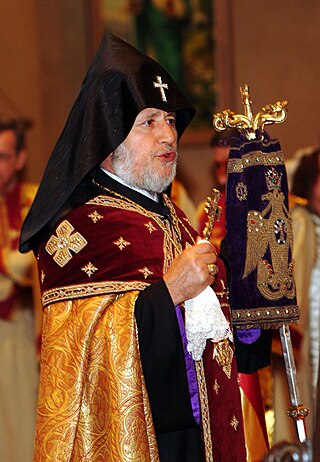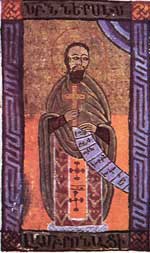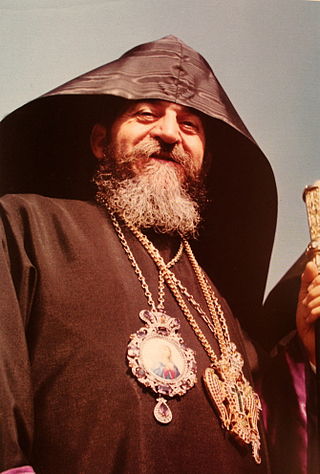
Kozan, formerly Sis, is a municipality and district of Adana Province, Turkey. Its area is 1,903 km2, and its population is 132,703 (2022). It is 68 kilometres northeast of Adana, in the northern section of the Çukurova plain. The Kilgen River, a tributary of the Ceyhan, flows through Kozan and crosses the plain south into the Mediterranean. The Taurus Mountains rise up sharply behind the town.

The Catholicos of All Armenians is the chief bishop and spiritual leader of Armenia's national church, the Armenian Apostolic Church, and the worldwide Armenian diaspora. The Armenian Catholicos is also known as the Armenian Pontiff and by other titles. According to tradition, the apostles Saint Thaddeus and Saint Bartholomew brought Christianity to Armenia in the first century. Saint Gregory the Illuminator became the first Catholicos of All Armenians following the nation's adoption of Christianity as its official religion in 301 AD. The seat of the Catholicos, and the spiritual and administrative headquarters of the Armenian Church, is the Mother See of Holy Etchmiadzin, located in the city of Vagharshapat.

The Armenian Apostolic Church is the national church of Armenia. Part of Oriental Orthodoxy, it is one of the most ancient Christian institutions. The Kingdom of Armenia was the first state in history to adopt Christianity as its official religion under the rule of King Tiridates III, of the Arsacid dynasty in the early 4th century.

Rumkale is a ruined fortress on the Euphrates, located in the province of Gaziantep and 50 km west of Şanlıurfa.
A catholicos is the head of certain churches in some Eastern Christian traditions. The title implies autocephaly and, in some cases, it is the title of the head of an autonomous church. The word comes from ancient Greek καθολικός, derived from καθ' ὅλου from κατά and ὅλος, meaning "concerning the whole, universal, general"; it originally designated a financial or civil office in the Roman Empire.

The Armenian Kingdom of Cilicia, also known as Cilician Armenia, Lesser Armenia, Little Armenia or New Armenia, and formerly known as the Armenian Principality of Cilicia, was an Armenian state formed during the High Middle Ages by Armenian refugees fleeing the Seljuk invasion of Armenia. Located outside the Armenian Highlands and distinct from the Kingdom of Armenia of antiquity, it was centered in the Cilicia region northwest of the Gulf of Alexandretta.

Toros Roslin ; c. 1210–1270) was the most prominent Armenian manuscript illuminator in the High Middle Ages. Roslin introduced a wider range of narrative in his iconography based on his knowledge of western European art while continuing the conventions established by his predecessors. Roslin enriched Armenian manuscript painting by introducing new artistic themes such as the Incredulity of Thomas and Passage of the Red Sea. In addition he revived the genre of royal portraits, the first Cilician royal portraits having been found in his manuscripts. His style is characterized by a delicacy of color, classical treatment of figures and their garments, an elegance of line, and an innovative iconography.

Karekin I served as the Catholicos of the Armenian Apostolic Church between 1994 and 1999. Previously, he served as the Catholicos of Cilicia from 1983 to 1994 as Karekin II.

Nerses IV the Gracious was Catholicos of Armenia from 1166 to 1173.

Saint Nerses of Lambron (1153–1198) was the Archbishop of Tarsus in the Armenian Kingdom of Cilicia who is remembered as one of the most significant figures in Armenian literature and ecclesiastical history.

Karekin I was a scholar of Armenian art and Catholicos of Cilicia of the Armenian Apostolic Church from 1943 to 1952.
Gregory V of Cilicia was the Catholicos of the Armenian Apostolic Church from 1193 to 1194.

Khoren I Paroyian was the Catholicos of the Holy See of Cilicia, from 1963 to 1983.
Catholicos Jacob I the Learned was the Catholicos of the Armenian Apostolic Church between 1268 and 1286.
Constantine II the Woolmaker was the Catholicos of the Armenian Apostolic Church between 1286 and 1289, and then again between 1307 and 1322.
Gregory VII was the Catholicos of the Armenian Apostolic Church between 1293 and 1307.

Sis was the capital of the Armenian Kingdom of Cilicia. The massive fortified complex is just to the southwest of the modern Turkish town of Kozan in Adana Province.

Armenian Prelature of Cyprus, is one of the oldest dioceses of the Armenian Apostolic Church outside the historic Armenian territories, covering the Republic of Cyprus. It has been founded during the 12th century and currently has around 3,500 followers, comprising around 95% of the Armenians in Cyprus. The diocese is under the jurisdiction of the Holy See of Cilicia of the Armenian Church.
The Council of Hromkla was a council of the Armenian Apostolic Church held in Hromkla in April 1178 or at Easter 1179, with the purpose of finalizing the union with the Eastern Orthodox Church. The council was convened by the Armenian Catholicos Nerses IV the Gracious, but since he had passed away, it was presided over by his nephew and successor, Gregory IV the Young. Its aim was to have the Armenian Apostolic Church adopt the outcome of the discussions between Nerses IV the Gracious and the Eastern Orthodox Church, including the recognition of dyophysitism, the belief that Jesus Christ would have two natures.
The fall of Sis or the siege of Sis was the capture of Sis and the destruction of the Armenian Kingdom of Cilicia by the Mamluk Sultanate. It occurred on 13 April 1375.












